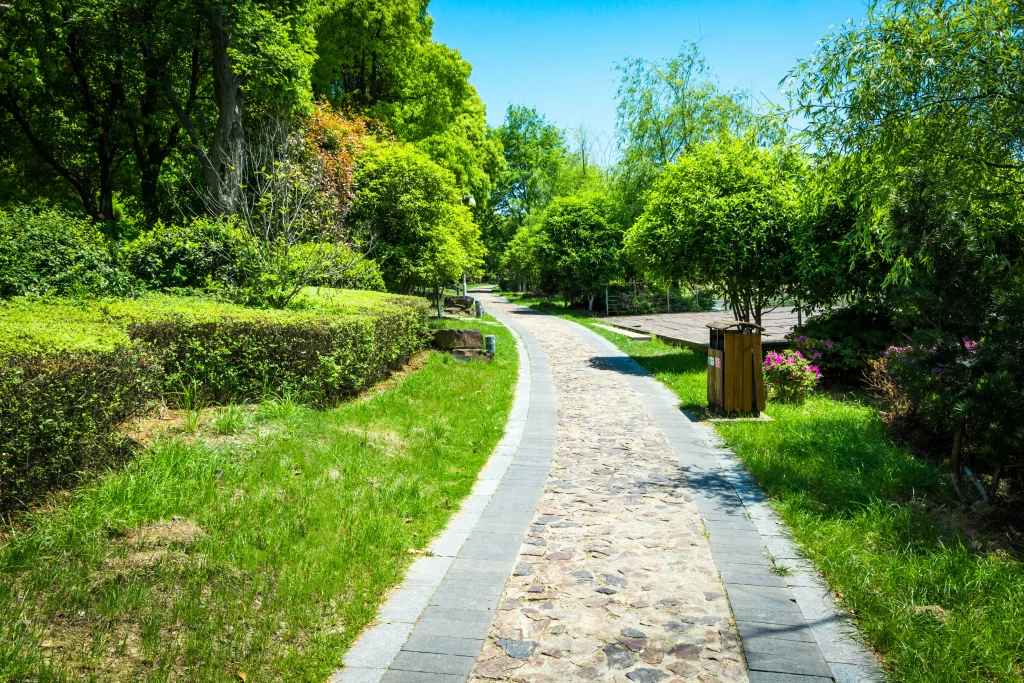Can you mow a wet lawn? The short answer: No, mowing a wet lawn risks damage to your grass, soil, and equipment. After rain or irrigation, Denver homeowners often face the dilemma of when to mow their saturated lawns.
This challenge intensifies during spring storms, following irrigation cycles, or after snowmelt in our unique climate. The temptation to cut wet grass often leads to problems that professional landscapers witness regularly.
Our experience shows that understanding when and how to mow in various moisture conditions preserves your lawn’s health and appearance. This guide covers the dangers of wet mowing, rare exceptions when it might be acceptable, and professional advice for Denver’s specific climate challenges.
Is It Safe to Mow a Wet Lawn?
Mowing wet grass creates multiple risks that lawn care professionals aim to avoid. When moisture saturates grass blades, the mower cannot perform its intended function properly.
Denver’s clay-heavy soils compound these problems by retaining moisture longer than sandy soils, especially in areas with poor drainage.
The primary risks of mowing wet lawns include:
Safety Concerns
Walking on wet grass while operating heavy equipment significantly increases slip and fall risk. Wet slopes become particularly dangerous, as both you and the mower can slide unexpectedly.
Power mowers (both electric and gas) also present electrical hazard risks when operated in wet conditions.
Damage to Grass Health
Wet grass blades bend instead of standing upright when approached by mower blades. Rather than delivering clean cuts, the mower tears and rips the grass.
These jagged tears create entry points for disease and stress the plant, potentially turning your lawn yellow or brown in sections where wet mowing occurred.
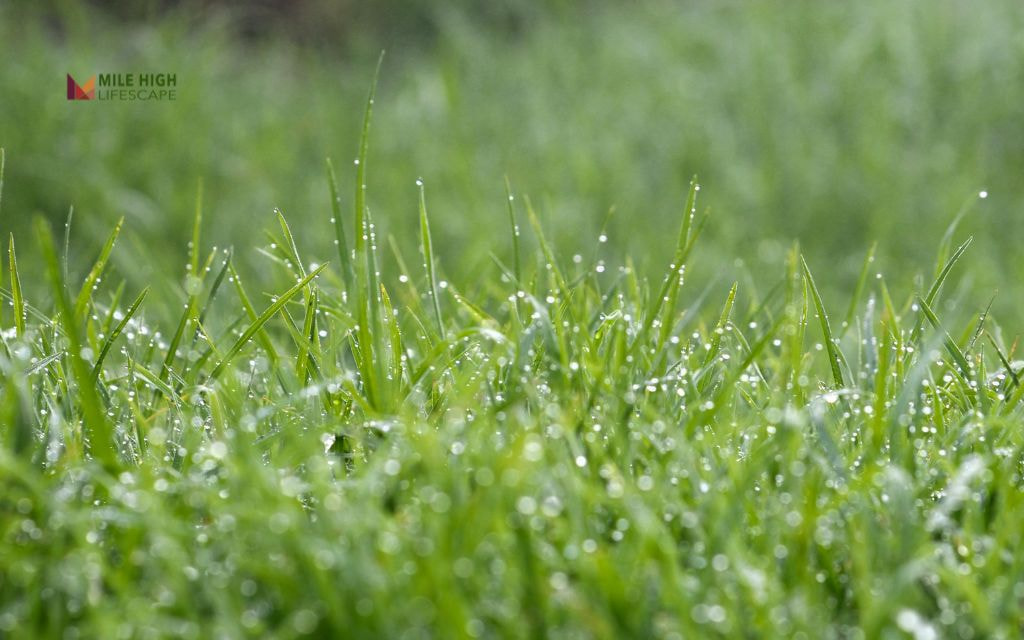
Soil Structure Problems
The weight of both you and your mower compresses wet soil, eliminating air pockets that grass roots need for oxygen. This compaction creates lasting damage to soil structure in Denver’s clay-rich environment.
Once compacted, these dense soil areas resist water penetration during future irrigation, creating zones of stressed, underwatered grass despite regular irrigation.
Uneven Cutting Results
Mower wheels sink into soft, wet soil, creating dips and uneven cutting heights across your lawn. The mower deck may scalp high spots while missing low areas entirely.
This uneven cutting pattern produces a visibly inconsistent appearance that may require repeated mowing to correct once conditions dry.
Clumping and Suffocation
Wet clippings stick together instead of dispersing evenly. These clumps block sunlight to underlying grass and create dense mats that smother healthy turf. In Denver’s climate, these wet clumps often dry into hard patches that kill the grass beneath them and require manual removal.
Disease Development Risk
Fungal spores thrive in moist environments. The combination of high moisture levels and damaged grass creates perfect conditions for lawn diseases to develop.
The mowing process itself spreads these pathogens throughout your yard as the wheels and blades move across infected areas to healthy sections.
Equipment Damage Potential
Wet grass adheres to mower components, creating additional resistance that strains engines beyond their designed capacity. This buildup clogs discharge chutes, rusts metal components, and creates unnecessary wear on moving parts.
The moisture also promotes corrosion that shortens your equipment’s lifespan and increases maintenance costs.
What Happens If You Mow Wet Grass?
Understanding the specific consequences helps homeowners recognize why patience pays off when dealing with wet lawns.
Uneven Cutting Results
Wet grass blades bend instead of standing upright under the mower. This creates sections where blades avoid cutting entirely while others experience scalping.
The result resembles a patchy, unprofessional appearance that may require correction once conditions dry.
Clumping Issues
Wet clippings stick together, forming dense clumps that block sunlight and airflow to living grass. These clumps create perfect conditions for fungal growth while preventing proper nutrient cycling. In Denver’s climate, these clumps dry into hardened patches that damage underlying turf.
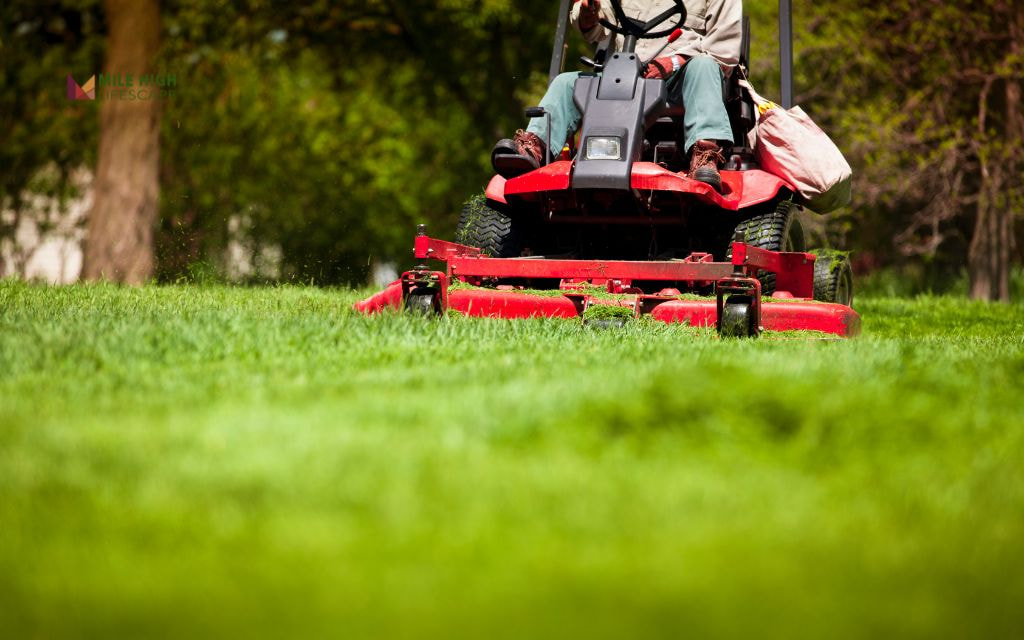
Soil Structure Damage
The weight of mowing equipment compresses saturated soil, eliminating essential air pockets that grass roots need. Denver’s clay-rich soil proves especially vulnerable to compaction, potentially causing long-term drainage problems that persist through multiple seasons.
Disease Promotion
Moisture combined with damaged grass creates ideal conditions for fungal pathogens. The physical act of mowing spreads these organisms throughout your lawn. Denver’s varied temperatures can accelerate fungal spread, especially during spring and fall transition periods.
Equipment Strain
Wet grass adheres to mower components, creating resistance that strains engines and dulls blades faster. The moisture causes rusting on metal parts and clogs discharge chutes.
Professional-grade equipment faces the same challenges, though commercial mowers incorporate design elements to minimize these effects.
When Is It Okay to Mow a Wet Lawn?
While generally inadvisable, some situations permit mowing slightly damp grass:
- Morning dew that will dry within the hour
- Lightly damp conditions before forecasted storms (when postponing means missing a full mowing cycle)
- Emergency situations requiring immediate yard maintenance
These exceptions remain rare. When absolutely necessary to mow damp grass, follow these practices:
- Perform the “boot test” – if your footprint remains visible or water appears, wait longer
- Raise the mower deck to cut less height
- Ensure blades maintain maximum sharpness
- Clean equipment thoroughly afterward
- Use side-discharge rather than mulching functions
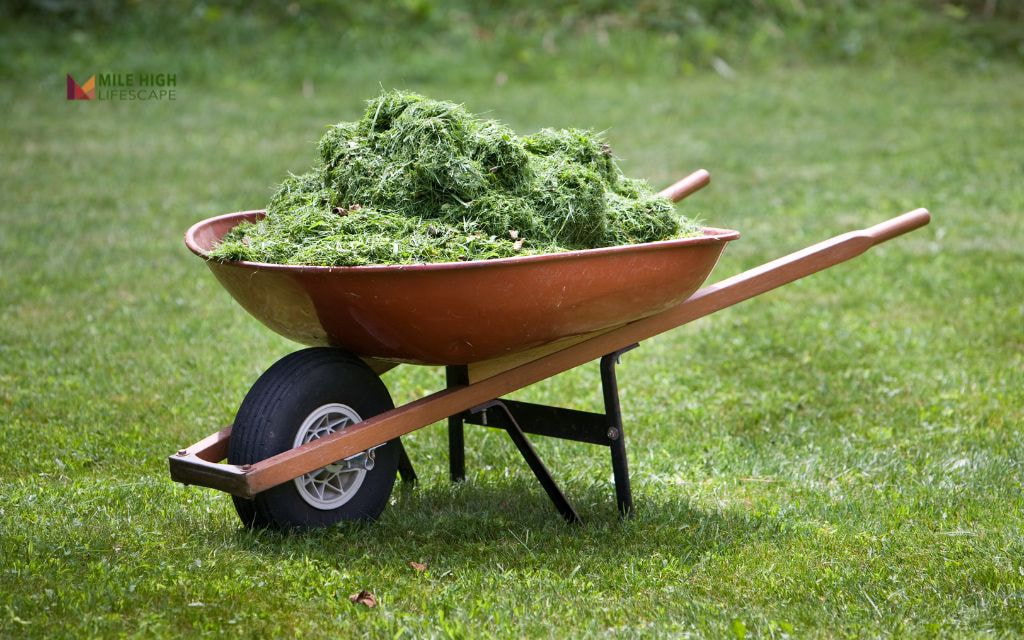
Tips for Mowing Wet Grass in Denver’s Climate
- Wait for Afternoon Sunlight: Denver’s abundant sunshine dries lawns quickly once direct sunlight hits. Schedule mowing for afternoon hours when morning moisture has evaporated, especially during spring and fall.
- Use Mulching Blades With Caution: Standard mulching operations fail in wet conditions. If using a mulching mower, reduce your pace significantly to allow proper processing of wet material.
- Clean Equipment Immediately: Grass buildup under the mower deck becomes cement-like when dried. Remove all wet grass from equipment surfaces before storage to prevent corrosion and maintain cutting efficiency.
- Modify Your Mowing Pattern: Longer, straighter passes reduce turns that can damage wet turf. This approach minimizes soil disruption while maximizing cutting efficiency in challenging conditions.
Best Practices for Denver Homeowners: Timing and Alternatives
Denver’s climate offers predictable drying windows that smart homeowners leverage for lawn maintenance.
The ideal mowing conditions include dry, sunny afternoons when temperatures reach their daily peak. Wind accelerates drying, making breezy afternoons optimal for mowing previously wet lawns.
For Denver-specific lawn care timing:
- Allow 24-48 hours after significant rainfall before mowing
- Avoid morning mowing during heavy dew seasons (spring/early summer)
- Utilize soil moisture sensors to optimize irrigation timing
- Schedule mowing 2-3 days after deep watering cycles
When waiting isn’t practical, consider these alternatives:
- String trimming high-priority edges and borders
- Spot-treating dry areas that need immediate attention
- Removing debris and performing light dethatching
- Focusing on other lawn maintenance tasks like aeration scheduling
What to Do When the Lawn Is Constantly Wet
Persistent lawn wetness indicates underlying issues that require attention beyond simple mowing adjustments. Common causes in Denver properties include:
Overwatering Problems
Many irrigation systems deliver more water than necessary for Denver’s climate. Adjusting watering frequency rather than duration often solves persistent moisture issues. The city’s semi-arid climate means lawns typically need less frequent irrigation than many automatic systems provide.
Drainage Deficiencies
Denver’s clay soils naturally retain water longer than other soil types. Properties with poor grading or compacted subsoil experience standing water that prevents normal drying. Professional core aeration creates channels for water movement through these dense soil structures.
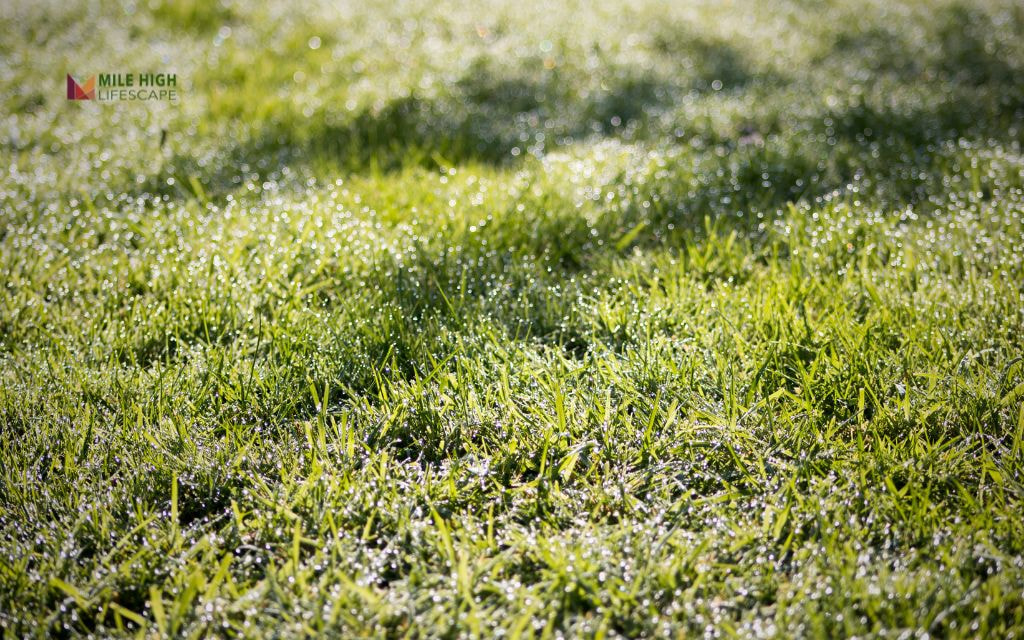
Shade-Related Issues
Areas under trees or buildings receive less direct sunlight, extending drying times significantly. These microclimates may require specialized grass varieties or modified maintenance schedules compared to full-sun sections of your property.
Practical Solutions
- Core aeration to improve soil permeability
- Installation of French drains in chronically wet areas
- Regarding to eliminate water-collecting depressions
- Transitioning to drought-tolerant grass varieties like Bluegrass hybrids or Fine Fescue that handle moisture fluctuations effectively
The Smart Move: When to Call in the Pros
Certain lawn moisture situations signal the need for professional intervention from lawn care services in Denver. When homeowners notice:
- Visible fungal growth or discoloration
- Repeated equipment failure when attempting to mow
- Standing water 48+ hours after precipitation
- Spongy soil texture persisting between rain events
Professional lawn care companies like Mile High Lifescape approach these situations differently:
- Conducting comprehensive soil moisture testing before mowing
- Utilizing specialized equipment designed for varied conditions
- Implementing strategic scheduling based on weather forecasting
- Recommending customized solutions for property-specific challenges
For Denver homeowners facing persistent lawn moisture issues, Mile High Lifescape offers free quotes and consultation services tailored to local conditions. Our team’s experience with Denver’s unique climate challenges ensures effective solutions for even the most challenging properties.
Conclusion
The golden rule remains: avoid mowing wet grass whenever possible. The short-term convenience rarely justifies the potential damage to your lawn’s health and appearance. Before starting your mower, evaluate current conditions, forecast weather, and equipment readiness.
Denver’s unpredictable spring and fall transitions create particular challenges for lawn maintenance timing.
During these seasons, professional lawn care services provide consistency that weather patterns often prevent for DIY homeowners. Contact Mile High Lifescape for guidance specific to your property’s needs and challenges.
Frequently Asked Questions (FAQs)
Can mowing wet grass damage my lawn permanently?
While not usually permanent, wet mowing causes stress that weakens grass and creates vulnerability to disease and weed invasion. Repeated wet mowing compounds these effects, potentially causing long-term turf deterioration.
Will mowing wet grass dull my mower blades?
Yes. Wet grass creates additional resistance that accelerates blade dulling. The moisture also causes grass to stick to blades, promoting rust and corrosion that further degrades cutting performance.
How long should I wait after rain to mow?
In Denver’s climate, wait 24-48 hours after significant rainfall. For light showers, 12-24 hours typically suffices during warm seasons. The “boot test” provides the most reliable indicator – if your footprint remains visible, wait longer.
Is there a mower that works well on wet grass?
While manufacturers claim “all-weather” performance, no mower truly excels on wet grass. Professional-grade equipment with high-lift blades and powerful engines performs marginally better, but still faces fundamental wet-cutting challenges.
What are signs my lawn needs drainage improvement?
Standing water 24+ hours after rain, spongy soil texture, moss growth, and visibly saturated areas indicate drainage issues. In Denver properties, persistent moisture in low-lying areas despite sunny conditions signals drainage problems requiring attention.
Can I mow my lawn with dew on it?
Light morning dew that will evaporate within an hour typically causes minimal issues. However, heavy dew that soaks grass blades creates the same problems as recently rained-on turf and should be avoided until dry.
How do I know if my grass is too wet to mow?
Perform the boot test – walk on your lawn and observe whether footprints remain visible or water appears around your shoes. If either occurs, the lawn remains too wet for mowing without risking damage to both grass and equipment.
